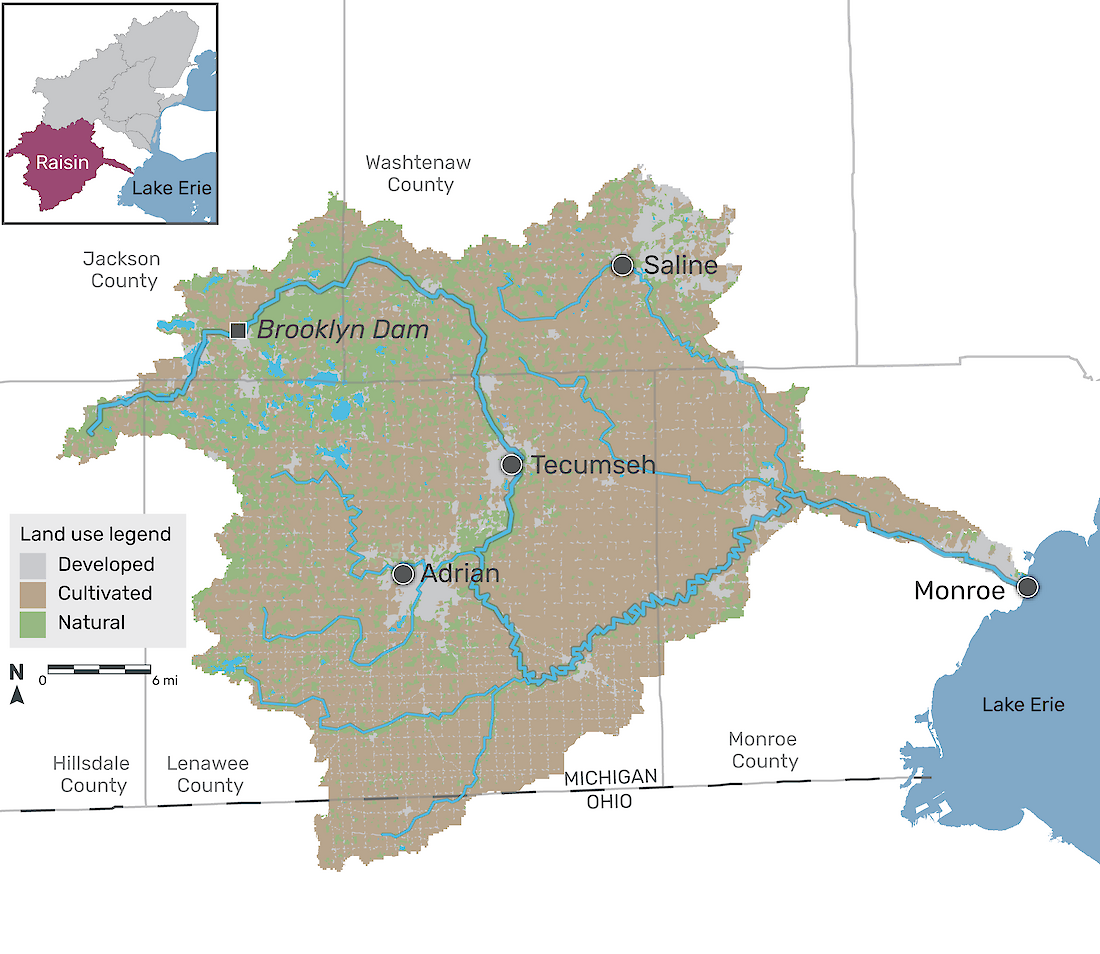 The River Raisin (Riviere Aux Raisin, River of Grapes), known first as “Nummasepee” (River of Sturgeon) by its American Indian inhabitants, drains to the Western Lake Erie Basin. The watershed covers most of Lenawee County and smaller portions of Monroe, Washtenaw, Jackson, and Hillsdale counties in Michigan along with a piece of Fulton County in northeastern Ohio, a total of about 1,059 square miles. The northwestern headwaters mark the most easterly advance of ancient glacial ice sheets in southeastern Michigan. The Irish Hills area, a unique local high point in Hillsdale County, is the headwaters for the Raisin, Grand, Kalamazoo, St. Joseph, and Maumee rivers. The River Raisin watershed includes the traditional lands of the Pottawatomi, Odawa, and Wyandot nations.
The River Raisin (Riviere Aux Raisin, River of Grapes), known first as “Nummasepee” (River of Sturgeon) by its American Indian inhabitants, drains to the Western Lake Erie Basin. The watershed covers most of Lenawee County and smaller portions of Monroe, Washtenaw, Jackson, and Hillsdale counties in Michigan along with a piece of Fulton County in northeastern Ohio, a total of about 1,059 square miles. The northwestern headwaters mark the most easterly advance of ancient glacial ice sheets in southeastern Michigan. The Irish Hills area, a unique local high point in Hillsdale County, is the headwaters for the Raisin, Grand, Kalamazoo, St. Joseph, and Maumee rivers. The River Raisin watershed includes the traditional lands of the Pottawatomi, Odawa, and Wyandot nations.
Industry in the form of mills throughout the watershed gave way to automobile manufacturing plants and eventually became home to some of the largest energy-generating plants in Michigan. The cost of doing business along the River Raisin resulted in some chronic pollution problems, but despite these challenges, the Raisin still has many beautiful natural wonders. The main stem of the river has some of the richest mussel beds in the state of Michigan. Forests, prairie fens, and remnant oak barrens support rare species such as the eastern massasauga rattlesnake, Blanchard’s cricket frog, the Indiana bat, the spotted turtle, and the Karner Blue butterfly. These same upper watershed areas are also among the most significant inland migratory bird stopover areas in the Western Lake Erie Basin.
The River Raisin Watershed Council

The members of the River Raisin Watershed Council. Photo courtesy of Meija Knafl.
The River Raisin Watershed Council (RRWC) was formed in 1974 under the state of Michigan’s Local River Management Act and is governed by a Board of Directors appointed by member municipalities. RRWC is a public service, non-profit, 501(c)(3) organization. The mission of RRWC is to inspire behaviors that promote stewardship, improve water quality, and encourage public participation to protect, preserve, and enhance the River Raisin Watershed.
The watershed council achieves these goals by working with partners on various activities, including classroom and public education, outreach to farmers, water quality monitoring, volunteer cleanups, and encouraging recreation on the river. Through these actions, the organization strives to promote and foster an understanding of the connection between our quality of life and the health and well-being of the watershed. To learn more about the vital work the RRWC does in the River Raisin watershed, visit RiverRaisin.org.
The River Raisin Watershed Council will celebrate 50 years of dedication to the river in 2024. Though the future will undoubtedly hold nearly as many twists and turns as the River Raisin itself, there will always be those who love the river and work hard to keep its waters clean and healthy. With the help of our residents and partners across the watershed, the future of the River Raisin is clear and bright.
Do you want to get involved in protecting the future of the River Raisin? Join us for an Adopt-A-Stream event to survey bugs living in the river, or participate in our Rescue River Cleanup Program to remove trash and invasive species. For educators, we offer classroom programs and field trips to help you teach about wetlands, migratory birds, and more! An annual poster contest is open for students pre-K through 12th grade to make art inspiring education and protection of our local river! Check out these and other programs at www.riverraisin.org.
